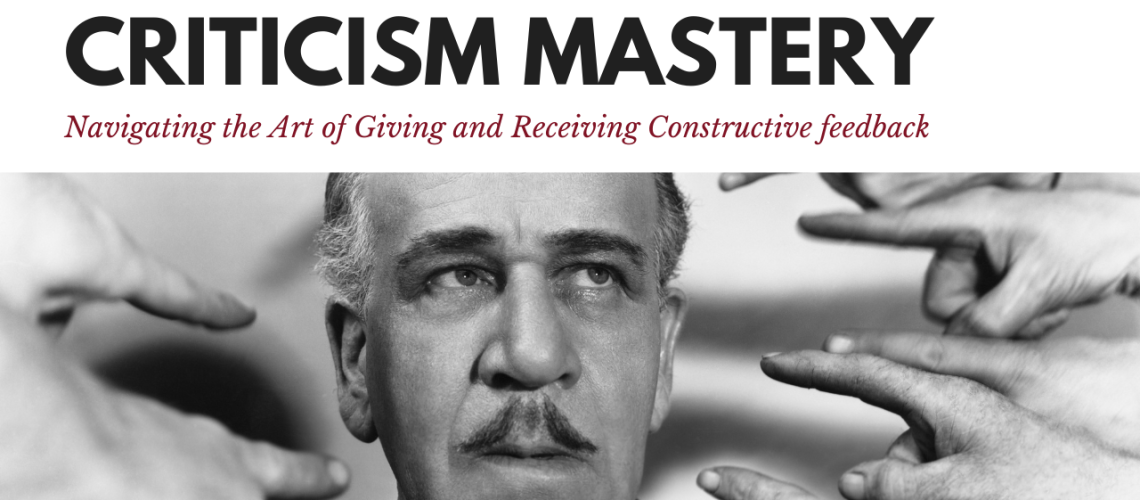By Dr. Salam Slim Saad
Welcome to the world of feedback – where opinions and perspectives collide! Constructive feedback. The very phrase is enough to make your palms sweat, your heart race, and your stomach churn. Whether you’re in the workplace, pursuing a creative endeavor, or simply navigating through life’s challenges, constructive criticism plays an invaluable role in personal growth and improvement.
Allow me to take you back to a crucial moment in my mid-career journey. I was a seasoned professional, well-versed in my field, and confident in my abilities. I was tasked with leading a critical project for a high-profile client. As I presented my strategy to the client’s top executives, I expected nods of approval and validation.
However, one senior executive, renowned for his discerning eye and straightforward feedback, raised his concerns. He pointed out flaws, questioned my approach, and challenged some key decisions. It felt like a barrage of criticism aimed directly at my expertise.
Initially, I felt defensive and caught off guard. Yet, as he continued with specific examples and suggestions, I realized he wasn’t attacking me but aiming to enhance our project’s success. His intention was to foster growth and improvement.
This moment exemplifies the profound impact of constructive criticism, even for seasoned professionals. It showed me that feedback, when delivered with empathy and a commitment to progress, can be a catalyst for continued development in any stage of one’s career.
In the world of professional growth and development, such experiences underscore the vital importance of constructive criticism. It is an art, a skill honed over time, and one that doesn’t discriminate based on experience. Whether you’re just starting out in your career or a seasoned veteran, the ability to give and receive constructive feedback is an invaluable asset.
What is constructive criticism?
Constructive feedback is an art. It’s a skill you can learn and practice, but that doesn’t mean it comes naturally to everyone. And if you’re not a natural at giving or receiving constructive feedback, you’re not alone. Giving feedback can be hard enough—you have to share your thoughts and feelings about the work someone else has done, which means you have to be honest. But receiving feedback is even harder because it means hearing something negative about yourself (even if it’s constructive).
It’s hard to give feedback. It’s even harder to receive it. And when you’re a manager, it can feel like you’re always responsible for giving constructive criticism.
Constructive criticism is a powerful tool that helps us grow and improve in various aspects of our lives. Essentially, it involves providing feedback or suggestions aimed at helping someone enhance their skills, performance, or behavior. Unlike destructive criticism which aims to tear down and belittle, constructive criticism takes a more positive approach.
At its core, constructive criticism is rooted in empathy and understanding. It acknowledges the strengths of an individual while also identifying areas where improvement can be made. By focusing on specific behaviors or actions rather than attacking personal traits, it creates a safe space for growth and development.
One key aspect of constructive criticism is its intention to offer guidance rather than judgment. It refrains from being overly harsh or negative and instead presents opportunities for learning and progress. This type of feedback aims to motivate individuals by highlighting their potential rather than discouraging them with harsh words.
Furthermore, constructive criticism fosters effective communication within relationships – be it professional or personal. By openly discussing concerns or areas for improvement, trust is built between parties involved, leading to enhanced collaboration and stronger connections.
Constructive criticism serves as a catalyst for self-reflection and continuous improvement. It encourages individuals to step outside their comfort zones and embrace new ideas while constantly striving for excellence.
Constructive Criticism Vs. Destructive Criticism
Constructive criticism and destructive criticism are two distinct approaches to providing feedback, each with its own impact on personal growth and development.
Constructive Criticism is aimed at offering helpful insights, suggestions, or recommendations that can assist an individual in improving their skills, performance, or behavior. It focuses on identifying areas for improvement while also acknowledging strengths and achievements. This type of feedback aims to be supportive and encouraging.
On the other hand, Destructive Criticism tends to be negative, hurtful, and unhelpful. It often attacks a person’s character rather than focusing on specific actions or behaviors. Destructive criticism can undermine confidence, create resentment or defensiveness, and hinder personal growth.
The main difference between constructive and destructive criticism lies in their intentions: one seeks to build up while the other tears down. Constructive criticism fosters learning opportunities by highlighting areas for improvement in a respectful manner. In contrast, destructive criticism often demoralizes individuals without offering any guidance for positive change.
Benefits of Constructive Criticism
Constructive criticism, often seen as a valuable tool in both personal and professional growth, offers a myriad of advantages. It serves as a guiding light, providing fresh perspectives, promoting self-awareness, fostering continuous learning, strengthening relationships, and fueling motivation and resilience. In this article, we explore these benefits in detail, highlighting how constructive criticism can be a catalyst for positive change and enhanced performance.
Here are some of the benefits of constructive criticism:
Gain New Perspectives
- Allows us to see our work or behavior from a different angle.
- Opens our eyes to overlooked mistakes or missed improvement opportunities.
Promotes Self-Awareness
- Helps us become aware of our strengths and weaknesses.
- Enables setting realistic goals and making better decisions.
Fosters Learning and Skill Enhancement
- Provides specific feedback on what was done well and areas for improvement.
- Offers opportunities to acquire new knowledge and refine skills.
Strengthens Relationships
- Fosters trust and respect when feedback is given openly and without fear.
- Creates an environment of openness and transparency for effective collaboration.
Fuel Motivation and Resilience
- Drives us forward and enhances motivation.
- Encourages bouncing back from setbacks and trying again.
How To Give Constructive Feedback
Offering constructive criticism is a crucial skill for personal and professional growth. Here are some effective tips for giving feedback:
Be Specific
- Provide concrete examples of what was done well.
- Explain why those actions or behaviors were effective.
Focus on Behavior
- Separate the person from their actions.
- Address specific behaviors to facilitate understanding and change.
Consider Timing
- Choose an appropriate time and place for delivering feedback.
- Ensure the recipient is receptive to your message.
Use Clear Language
- Avoid vague statements or generalizations.
- Convey your message clearly and concisely.
Start with Positivity
- Emphasize positive aspects before mentioning areas for improvement.
- Maintain motivation and confidence while encouraging growth.
Utilize the Sandwich Method
- Start with a positive comment.
- Address areas for improvement.
- End with another positive remark.
Actively Listen
- Encourage the recipient to share their thoughts or ask questions.
- Promote productive dialogue and understanding.
Consider Nonverbal Cues
- Be mindful of body language and tone of voice.
- These cues greatly impact how your message is received.
Ask Open-Ended Questions
- Encourage reflection and self-assessment.
- Enable individuals to take ownership of their performance and identify areas for improvement.
Offer Support and Guidance
- Provide resources, assistance, or training opportunities.
- Facilitate growth by supporting the implementation of changes.
13 Quick Tips for Giving Constructive Criticism
Constructive criticism is essential for growth. Here are 13 tips to give feedback effectively:
- Be Specific: Clearly identify the issue.
- Focus on Actions: Critique behavior, not the person.
- Use “I” Statements: Share your observations.
- Offer Improvement Suggestions: Provide actionable recommendations.
- Choose the Right Setting: Find a private, comfortable space.
- Timing is Crucial: Select a moment when emotions are calm.
- Start with Positives: Highlight what was done well.
- Avoid Absolutes: Use words carefully.
- Provide Examples: Back your critique with instances.
- Be Empathetic: Understand the difficulty of receiving criticism.
- Listen Actively: Give space for responses.
- Focus on Collaboration: Offer support and resources.
- End on a Positive Note: Express confidence in growth
How to Receive Destructive Criticism Effectively with Examples
Receiving destructive criticism can be even more challenging than constructive criticism, as it is aimed at tearing you down rather than offering valuable insights for improvement. It’s essential to remember that not all feedback is helpful or productive. When faced with destructive criticism, it’s crucial to maintain your composure and not let it affect your self-esteem. Instead, use it as an opportunity for personal growth and resilience.
Assess the Validity of the Critique: Take a moment to evaluate whether the criticism has any merit. If it lacks constructive elements or seems solely designed to harm, consider disregarding it altogether.
Reframe as Opportunities for Growth: View destructive criticism as a chance to improve and strengthen your skills. For example:
Example 1: If someone criticizes your presentation as terrible and lacking substance, see it as an opportunity to enhance your public speaking skills and content development for future presentations.
Example 2: When receiving harsh feedback on a piece of writing, use it as motivation to refine your writing style and improve clarity in future projects.
5 Things to Avoid When Receiving Constructive Criticism
Receiving constructive criticism is crucial for personal and professional growth, but it can be challenging. Here are some things to avoid when receiving constructive criticism:
- Becoming Defensive: Resist the urge to become defensive when receiving feedback. Keep an open mind and listen to understand the perspective being shared.
- Taking It Personally: Avoid taking constructive criticism as a personal attack. Instead, view it as an opportunity for improvement.
- Ignoring Feedback: Embrace feedback, even if it feels uncomfortable initially. Discomfort often leads to growth.
- Failing To Ask For Clarification: Seek clarification if the feedback is unclear or vague. This shows your willingness to understand their perspective better.
- Not Taking Action: Don’t simply acknowledge feedback without taking action. Use it as a catalyst for positive change and improvement in your work or behavior.
Conclusion
In the world of feedback, where opinions and perspectives converge, always remember: ‘Constructive criticism is the art of growth.’ While it may not come naturally, its power lies in nurturing empathy, fostering self-awareness, and fortifying relationships. Embrace it, whether you’re giving or receiving, as a continuous path to improvement.
Indeed, delivering effective criticism is no easy feat; it’s a skill that matures with time and can distinguish a proficient designer from one who’s truly mastered their craft. To enhance your critique abilities, follow the guidelines in this article. Critical thinking forms the bedrock of providing valuable feedback, a skill you can begin honing today.



